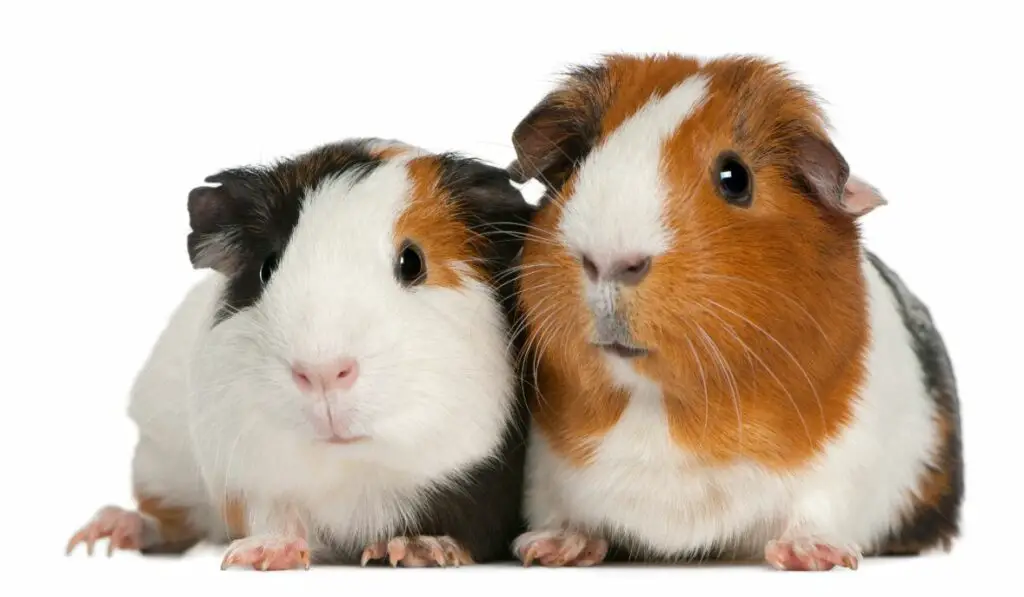If you’re a guinea pig owner, you may be considering adding another one to your family. Guinea pigs are social animals, and keeping them alone can lead to boredom, loneliness, and even depression. But introducing guinea pigs to each other can be a process that requires patience and careful preparation.
In this comprehensive guide, we’ll cover everything you need to know to introduce your guinea pigs to each other successfully.

Prefer a video guide? Check out this video we created:
Why Introducing Guinea Pigs to Each Other is Important
Guinea pigs are social animals, and they thrive in groups. Socializing your guinea pigs has several benefits for both their physical and emotional wellbeing.
Health Benefits of Socializing Guinea Pigs
Socializing your guinea pigs can have significant health benefits. Guinea pigs that live alone may be more prone to illnesses and infections because their immune systems are weaker than those of guinea pigs that live in groups. Socializing your guinea pigs can also help prevent obesity, which can lead to health problems like heart disease.
Reduction of Stress and Boredom
Guinea pigs that live alone can become bored and depressed, which can lead to destructive or aggressive behavior. Socializing your guinea pigs can alleviate boredom and stress, keeping them happy and healthy.
Emotional Benefits for Your Pet
Guinea pigs that are socialized are generally happier and more content. They enjoy playing and interacting with other guinea pigs, which can lead to a more fulfilling life.
When to Introduce Guinea Pigs to Each Other
When introducing guinea pigs to each other, several factors need to be considered.
Age and Gender Considerations
It’s essential to consider the age and gender of the guinea pigs you’re introducing. Guinea pigs of the same gender typically get along better than guinea pigs of different genders. However, if you’re introducing guinea pigs of different genders, it’s best to get them spayed or neutered to prevent unwanted breeding and aggression.
Health and Wellness Factors
It’s crucial to ensure that the guinea pigs you’re introducing are healthy and free of any illnesses or injuries. Sick guinea pigs may be more likely to spread illness to others, and injured guinea pigs may be more vulnerable during the introduction process.
Preparing for the Introduction
Preparing for the introduction is a crucial step in ensuring a successful socialization process.
Cage and Space Set-Up
Before introducing the guinea pigs, make sure that their living space is big enough to accommodate them comfortably. Provide plenty of hiding places, toys, and food bowls to prevent competition.
Hygiene and Cleanliness
Cleanliness is essential when introducing guinea pigs to each other. Make sure that the living space is thoroughly cleaned and disinfected before introducing new guinea pigs to prevent the spread of illnesses.
Food and Water Management
Ensure that there is plenty of food and water available for all guinea pigs during the introduction process. Consider adding extra food bowls and water bottles to prevent competition.
Behavioral Observation and Monitoring
It’s crucial to observe and monitor the behavior of the guinea pigs during the introduction process. Look for signs of aggression, fear, or stress, and intervene if necessary.
The Introducing Process
The introducing process can be a gradual process that requires patience and care.
Initial Introduction Strategy
The initial introduction should be done in a neutral space, such as a playpen or a large box. Allow the guinea pigs to explore and get used to each other’s presence without any physical contact.
Observation and Analysis
Observe the guinea pigs’ behavior during the introduction process. If one guinea pig becomes aggressive, separate them immediately to prevent injury.
Addressing Aggression and Fear
If one guinea pig becomes aggressive, try to identify the source of the aggression and address it. Introducing guinea pigs can be a stressful process for them, so it’s important to be patient and understanding.
Gradual Integration Techniques
Gradual integration techniques, such as swapping bedding or providing shared toys and food bowls, can help acclimate the guinea pigs to each other’s presence.
Post-Introduction Care
After the guinea pigs have been successfully introduced, it’s essential to provide proper care and attention.
Quarantine and Medical Observations
Newly introduced guinea pigs should be quarantined for at least two weeks to ensure they are healthy and free from any illnesses. Monitor their behavior and health during this time.
Diet Management and Feeding Schedule
Ensure that all guinea pigs have access to food and water, and monitor their diet to prevent obesity and other health problems.
Giving Attention and Playtime
Guinea pigs require attention and playtime to stay healthy and happy. Spend time with them daily, providing toys and activities to keep them entertained.
Conclusion
Introducing guinea pigs to each other can be a process that requires patience, care, and attention. However, the benefits of socializing guinea pigs are significant, leading to happier, healthier pets.
By following the tips and techniques outlined in this guide, you can successfully introduce your guinea pigs to each other and provide them with a fulfilling and happy life.
- How Long Do American Eskimo Dogs Live? Important Factors and Care Tips - September 29, 2023
- Do American Bulldogs Need Grooming? Essential Tips and Care Guidelines - September 29, 2023
- Do Bengal Cats Enjoy Playing? Essential Tips for Keeping Them Active - September 29, 2023